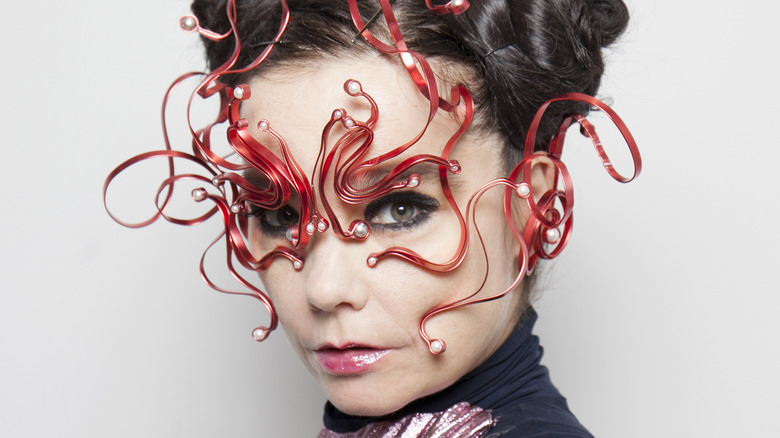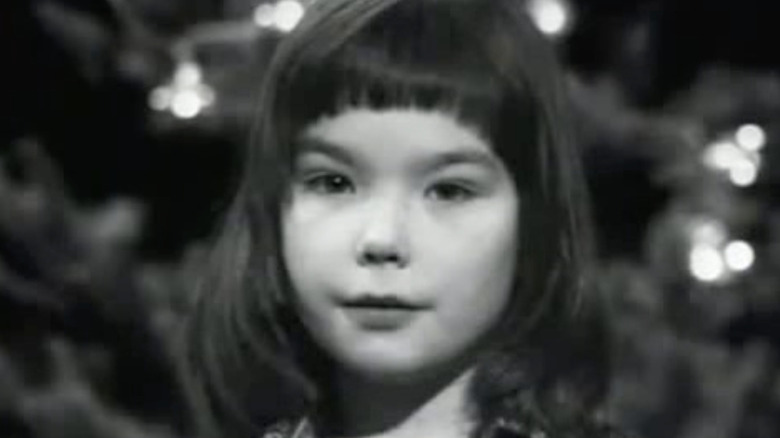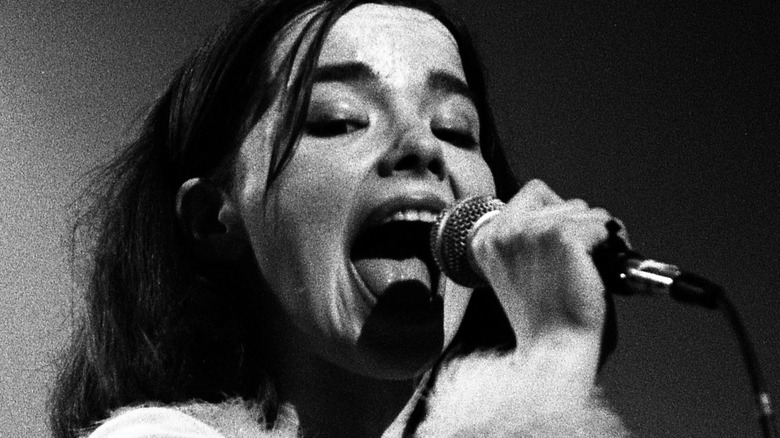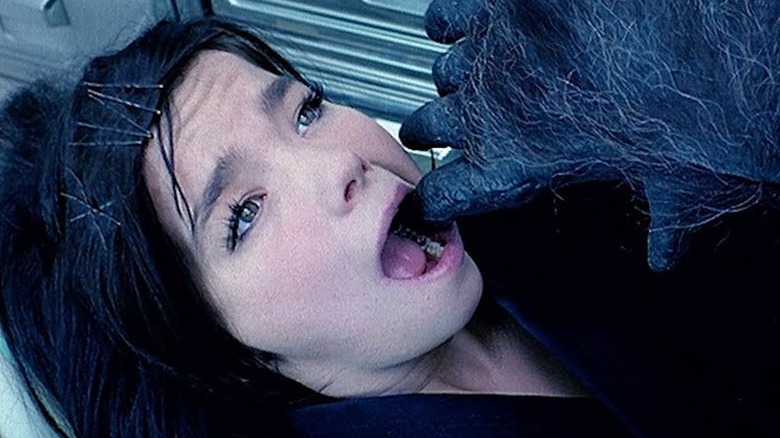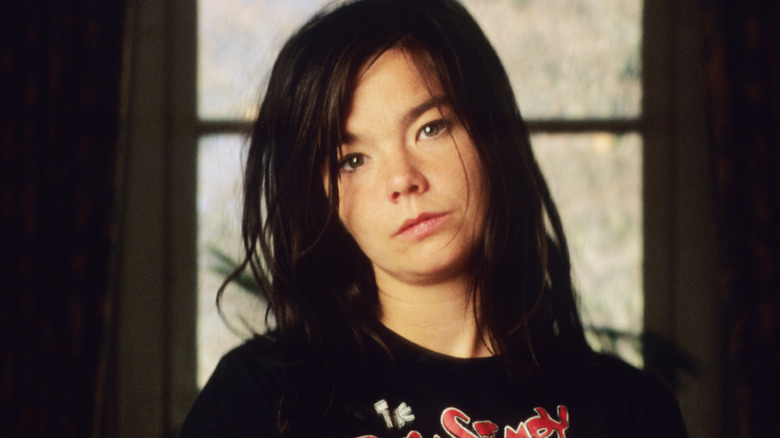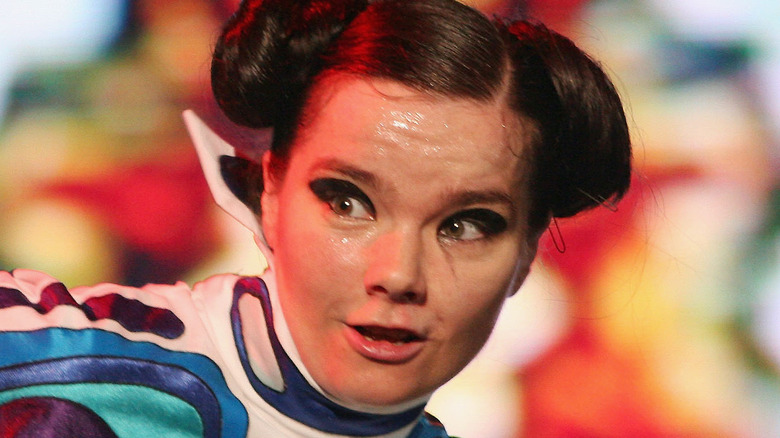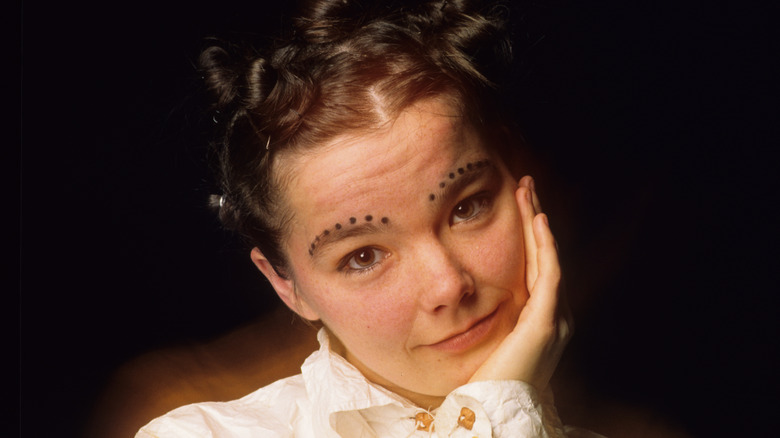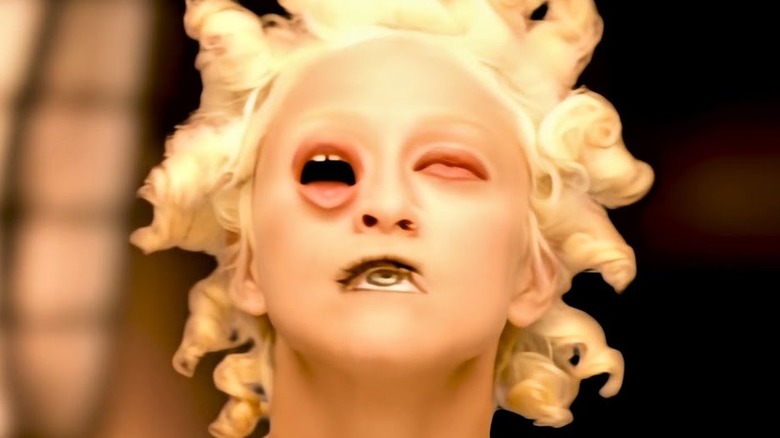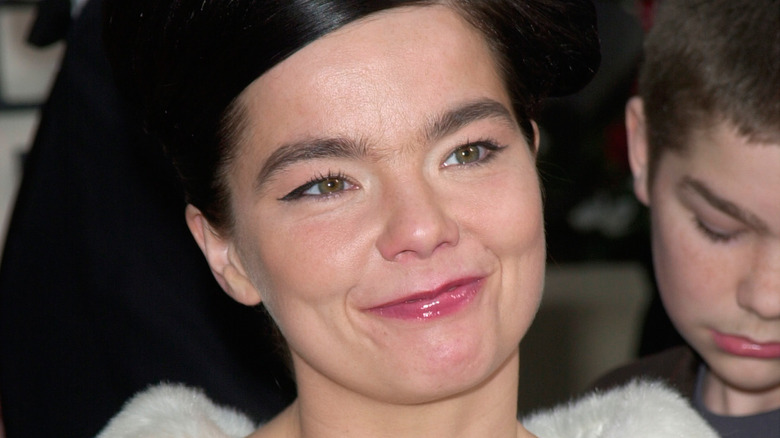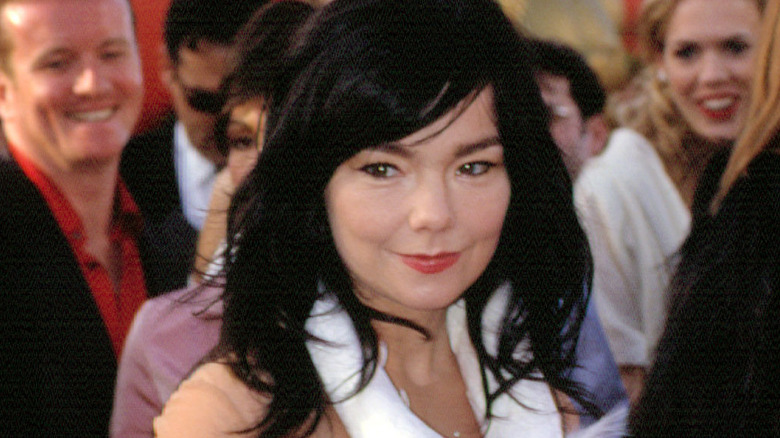The Untold Truth Of Bjork
It's difficult to describe or categorize Bjork. Emerging in the 1980s as the energetic, devilishly-angelic voiced lead singer of the experimental but danceable Icelandic alternative rock band the Sugarcubes, Bjork became a singular cultural voice in the 1990s and new millennium, blending electronic sounds and traditional instrumentation with folk, mythology, and storytelling to craft a unique style of captivating and sometimes baffling performance art. Add in her wildly original fashions (including wearing a "swan dress" to the Academy Awards) and memorable videos for singles like "Human Behaviour," "It's Oh So Quiet," "Army of Me," "Bachelorette," and "All is Full of Love," and Bjork is nothing short of a dazzling force of nature and artistic momentum.
Bjork is forever fascinating if also inscrutable, so let's explore, as much as can be done, the history, motivations, and accomplishments of the singer, actor, songwriter, celebrity, and artist. Here's the untold truth of Bjork.
Bjork was a child star in Iceland
Bjork first received international attention in the 1980s as the kinetic fronteprson of the noise-rock band the Sugarcubes, but her musical career dates way back to 1976, when the singer was just 11 years old. Bjork sang a simple vocals-and-guitar cover of "I Love to Love," a disco song by British star Tina Charles, during a recital for Barnamúsíkskóli Reykjavíkur, the Reykjavik, Iceland, music school in which he'd been enrolled since the age of five. According to Far Out, the performance was so impressive that it found its way to one of Iceland's few radio stations and was such a hit that Bjork managed to get a record deal, thanks to some negotiation from her connected stepfather.
That album, officially untitled and released in Iceland only in December 1977, consisted of 10 songs, some original tunes (co-written by Bjork's stepfather) and some covers of well-known pop and rock songs, but translated into Icelandic. Among these early Bjork recordings are "Bukolla," a version of Stevie Wonder's "Your Kiss is Sweet," and "Alfur Ut Ur Holt," a take on the Beatles' "The Fool on the Hill." Only 7,000 copies of the album (with cover art designed by Bjork's mother) were produced on vinyl and cassette, and after middling to poor reviews, Bjork turned down the chance to make a second record and took the money she made and bought a piano so she could start composing music.
Bjork was a punk
According to AllMusic, the Sugarcubes formed in 1986. The group, which would score some hits in the emerging, late '80s alternative rock scene, like "Hit," "Birthday," and "Motorcrash," consisted of veterans of various short-lived and often experimental Icelandic bands, particularly lead singer and former child sensation Bjork. After the straightforward pop she recorded as a tween, but before the haunting and spacey rock of the Sugarcubes, Bjork delved into punk, post-punk, and jazz-punk fusion.
According to Crack Magazine, Bjork formed an all-female punk band called Spit and Snot (also known by the similar Saliva and Phlegm) at the age of 13. After just a few months, she dissolved the project in order to join a jazz-influenced collective called Exodus before connecting briefly and variously with a number of other punk-inspired bands like Jam 80 and Rokka Rokka Drum, and the classic rock cover band Cactus (per Exclaim). At one point, Bjork was part of Scud, a death metal group. By 1982, 16-year-old Bjork was fronting the Cure-esque Tappi Tikarrays (whose name translates to "cork the b****'s a**".) Tappi Tikarrays released an EP and a full-length album before splitting up in 1983, freeing the singer to join the artsy, anarchist-minded KUKL (which means "witchcraft").
The meaning of Bjork
"Bjork" is a stage name for the internationally famous performance artist of Icelandic origin, but it's also a truncated version of the singer's full name. Her complete and full appellation is Bjork Guðmundsdóttir, which adheres to traditional Icelandic naming convention. But according to "Language Conflict and Language Rights" by William D. Davies and Stanley Dubinsky, last names in Iceland aren't enduring family names that last indefinitely, passing down from one generation to the next, but instead provide information about the identity of one's direct predecessors. Bjork's father (per Iceland Travel) is a man named Guðmundur Gunnarsson, so his last name translates to "son of Gunnar," referring to his father. As Bjork Guðmundsdóttir is the daughter of Guðmundur, her surname is Guðmundsdóttir, or "daughter of Guðmundur."
As for the performer's first name, it means "birch tree" in Icelandic (according to Behind the Name), and is also widely mispronounced. Often said like "bee-york," it's more properly pronounced "bee-yerk."
MTV twice banned Bjork
Bjork is a true master of the music video. She's earned seven MTV Europe Music Awards nominations and seven MTV Video Music Awards nods for clips like "Human Behaviour," "It's Oh So Quiet," and "All is Full of Love." But the powers that be at MTV are almost as likely to punish Bjork as they are to praise her.
The 1995 video for "Army of Me" was "edited for some broadcast networks," according to director Michel Gondry. Presented as a stark action film, it includes a scene of Bjork using a bomb to explode an art museum. Per Mark Pytlik's "Bjork: Wow and Flutter," MTV never aired the video in full, pulling it from playlist consideration in the wake of the domestic terrorist bombing of the Murrah Federal Building in Oklahoma City around the time "Army of Me" was released. (Two edited, explosion-free cuts were made and distributed to American TV outlets instead.)
Six years later, Bjork produced a video for "Pagan Poetry," a single from her 2001 album "Vespertine." Because of its artfully cut up and distorted images of sexual acts in progress, MTV wouldn't air the video at all, only airing it later on an MTV2 special about banned and controversial clips, according to Diffuser. The follow-up, "Cocoon," was banished to little-watched wee hours, as it involved Bjork dressed in a tight-fitting bodysuit that made her appear naked as blood-red threads thrust out of her chest and eventually consume her.
Welcome to Bjork Island
Bjork is certainly the world's most famous person to ever come out of Iceland, if not the most culturally and artistically influential. So the government of the tiny, isolated, sparsely populated Scandinavian nation wanted to show its appreciation for the performer, but in a unique, special, and grand fashion. And so, they tried to gift Bjork her very own island. "Bjork has done more for the popularity of Iceland than most other Icelanders," David Odds-on, prime minister of Iceland, told Althing, the country's parliament, in 2000 (according to Salon). "My view is that she may be given the use of this island as a royalty payment, as recognition from the state."
Four years later, Bjork revealed that she'd politely rejected the offer out of privacy concerns. "If you're given an island they'll have tourist boats circling around it pointing at you," she said (via the Irish Examiner). "I already get stalked down the street in Iceland and get tourists that walk up to me and poke me with their finger like they've just bought a trip to Disneyland and they met Donald Duck."
Bjork was caught in a love triangle
Bjork was just about at the peak of her commercial viability, cultural influence, and visibility in the mid-1990s, the same time that electronic music was emerging as a pop music phenomenon (according to Slate) and its DJs and practitioners of its many sub-genres (drum and bass, house, jungle) were becoming stars. Among the newly minted celebrities from that world: Goldie and Tricky, both who would find themselves ensnared in a passionate romantic entanglement with the similarly single-named Bjork.
In 1996, according to Spin, Tricky was hanging out at the New York dance club the Roxy and happened to run into Goldie, who he'd known since they were both teenagers growing up in the U.K. The exchange was cordial at first but quickly descended into hostility and chaos. Goldie had arrived with his fiancée, Bjork, who had once also been romantically involved with Tricky. Conversation turned into yelling, and yelling turned into shoving.
Bjork is an extremely sympathetic figure
In 1996, Bjork dealt with the ugly side of celebrity when she was nearly attacked by an overly fixated fan who turned to violence both outward and tragically inward when processing his feelings toward the experimental-pop star. According to ABC News, Miami-based pest exterminator Ricardo Lopez had become obsessed with Bjork in 1993, filling diaries and recording hours of videotape detailing his thoughts on the star. Three years in, Lopez grew deeply enraged when Bjork began dating electronic musician Goldie, a Black man, and came up with what he called a "deliciously sadistic plan." Lopez built a sulphuric acid bomb into a book and, finding the address of Bjork's London home, mailed it off, including a fake letter from a record company to persuade the singer to open the book, at which point it would shoot painful, toxic acid onto her face. After sending the bomb, Lopez went home, turned on a Bjork album, and died by suicide.
According to Salon, police in the U.K. were able to retrieve the letter bomb before it reached Bjork's home and did any damage. Learning of the attempt to injure her, Bjork took her young son away to Spain, but then sent flowers and a personal note to Lopez's grieving parents. "It's a very sad thing," Bjork told reporters, adding that she was more concerned for her son's feelings than for her own.
If you or anyone you know is having suicidal thoughts, please call the National Suicide Prevention Lifeline at 1-800-273-TALK (8255).
Bjork doesn't like to be bothered at the airport
Bjork is a public figure and puts her artistic endeavors on display and on sale for all the world to see, but she has to draw the line somewhere. Namely, she doesn't like being approached by members of the media at airports.
In March 1996, reporter Julie Kaufman told Reuters (via Time) that she encountered Bjork in the airport in Bangkok, Thailand. "All I said was, 'Welcome to Thailand,' and she just hit me, lost control and went crazy," Kaufman said, reporting that Bjork knocked her to the ground and smashed her head hard into the ground. Bjork released a public statement of apology and personally telephoned Kaufman, claiming that she had been so upset because she was with her nine-year-old son, Sindri, at the time of the encounter.
According to Reuters, a similar incident went down at Auckland International Airport in New Zealand in January 2008. This time, a photographer took some photos of Bjork shortly after she arrived in the country for a concert. He reportedly didn't respect Bjork's request to avoid photographing her, so she went on the offensive, tearing his shirt in half.
Bjork rocked Madonna's world
For her 1994 album "Bedtime Stories," Madonna explored atmospheric and electronic sounds and esoteric, poetic lyrics, particularly in the single "Bedtime Story." In other words, she tried to make a Bjork song — and got the alternative rock star to co-write the tune for her. The single was such a departure for Madonna that it became her first single to miss the American Top 40 since 1982, peaking at #42, which also makes it the highest-charting song with which Bjork had any involvement.
Bjork built the song around what would become the lyrical hook of "Bedtime Story," the line "Let's get unconscious, honey." According to Nylon, those words were a building block because Bjork thought it would be interesting to hear the monumentally famous and popular Madonna say that phrase. "At the time, the words I thought she'd say were, 'I'm not using words anymore, let's get unconscious honey,'" Bjork said. "'Just to be intuitive. Be more free. Go with the flow,'" she added, suggesting that she was responsible for Madonna's subsequent "mellowing-out" career phase.
The jazzy side of Bjork
While still an active member of the Sugarcubes, Bjork explored non-rock, and familiar and traditional sounds, joining up with an old-fashioned jazz trio to record the 1990 album "Gling-Glo." After performing with the piano, drum, and bass group, Bjork laid down vocals for the album, a collection of Icelandic and jazz standards officially credited to Tríó Guðmundar Ingólfssonar.
Singing jazz wasn't really a lark for Bjork, more of a return to form. Back in 1982, according to Exclaim!, Bjork was friendly with the members of Stifgrim, a rock duo based in Reykjavik, Iceland, who largely improvised their performances. Bjork performed with Stifgrim on occasion, including an ambitious attempt to go for the Guinness World Record for "longest continuous live performance." Despite 100 indie and underground Reykjavik bands taking turns playing for 12 hours straight each over the course of several weeks, the record wasn't secured.
Bjork's acting career was brief
Like many other famous musicians — Elvis Presley, David Bowie, Lady Gaga, Will Smith — Bjork did a little acting along with her singing. After appearing in the TV movie "Broken Glass" in 1988 and the indie film "The Juniper Tree" in 1990, Bjork made her first major appearance in a motion picture after the launch of her solo career in 2000's "Dancer in the Dark," a bleak, emotionally devastating musical about an economically struggling single mother going blind. Bjork dazzled critics and awards bodies with her performance, earning a Golden Globe nomination and the Best Actress award at the Cannes Film Festival. After accepting the latter prize, Bjork announced at the ceremony that she was done with acting, saying that "Dancer in the Dark" would be her "first and last" film, according to The Guardian. "I only have 50 years left, and I've got a lot of records to make," Bjork said.
Seventeen years later, Bjork clarified the reasons behind her aversion to film, namely that she was treated as a "lesser sexually harassed being" on the set of an unnamed movie by a "Danish director." As Bjork only made one major film, she didn't have to mention Danish-born "Dancer in the Dark" helmer Lars Von Trier by name in the Facebook post. Bjork stuck to her decision to avoid films for more than two decades, returning to the big screen in 2022 with a role in the Scandinavian historical epic "The Northman."
A lot of big movies failed to star Bjork
Just because Bjork announced she didn't want to act following a harrowing and offensive experience on the set of "Dancer in the Dark" doesn't mean filmmakers didn't try to get the singer to appear in their movies. For years, Bjork rejected every acting offer that came her way, and some of those projects turned out to be blockbusters or cult favorites.
According to Rolling Stone (via MassLive), Bjork was on the first and short list of actors producers wanted for what became the 2000 big-screen adaptation of "Charlie's Angels," taking on one of the roles of the titular super-spy trio. And according to Bjork biographer Emily Mackay in The Quietus, the singer passed on the chance to star in the big-budget adaptation of the popular dystopian comic book "Tank Girl." The 1995 film turned out to be a critical and commercial bomb, but the soundtrack spawned a hit single in Bjork's "Army of Me."
Bjork isn't an elf, but she likes elves just fine
Likely because of her diminutive stature, high-pitched speaking voice, and creative and playful persona, Bjork has frequently and colloquially across her career been described as "elfin" or elf-like. Helping that categorization stick and endure — the singer is from Iceland, where elves figure large in the collective consciousness and local mythology, according to The Atlantic.
It's a classification that Bjork doesn't enjoy. "I sometimes wonder what they would say if I was from Leeds," Bjork said in 2004 (via the Irish Examiner). However, large swaths of contemporary Icelanders believe that invisible elves are active mischief makers, and despite not liking being personally compared to the tiny humanoid creatures, Bjork thinks elves (and fairies) are real. "We think nature is a lot stronger than man," Bjork reasoned to Time in 2001. "It's sort of a relationship with nature," she explained on "The Colbert Report" in 2012. "It's all about respect."
